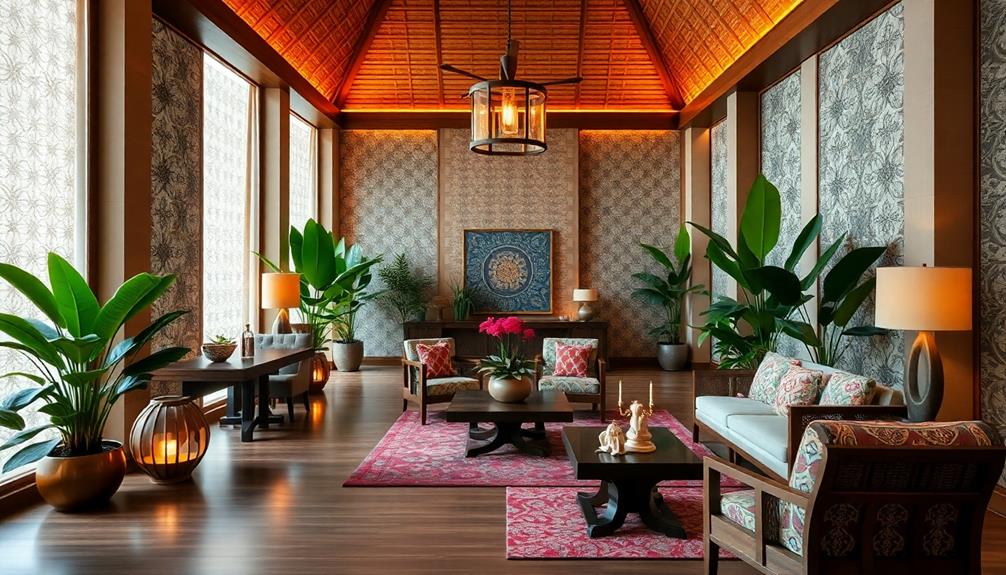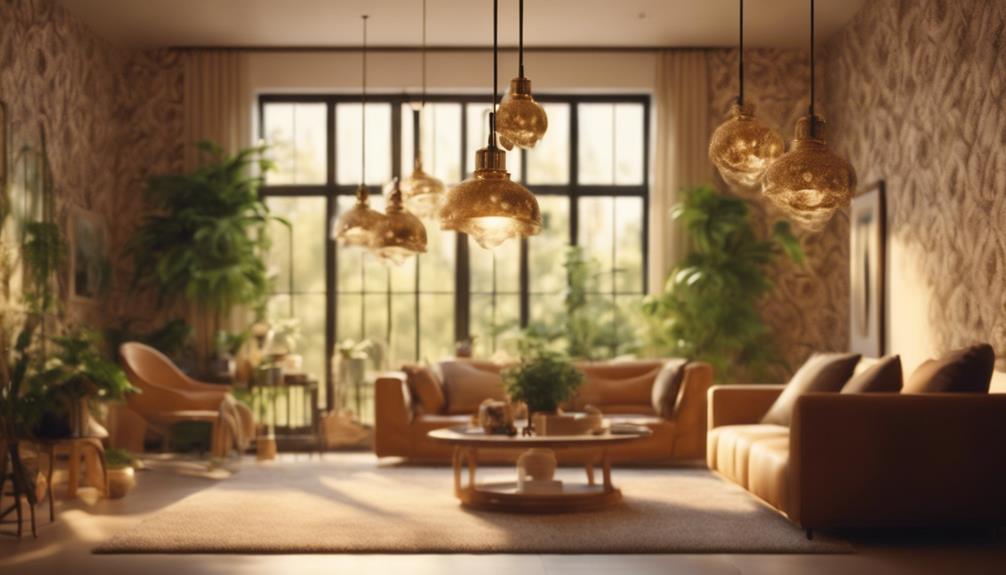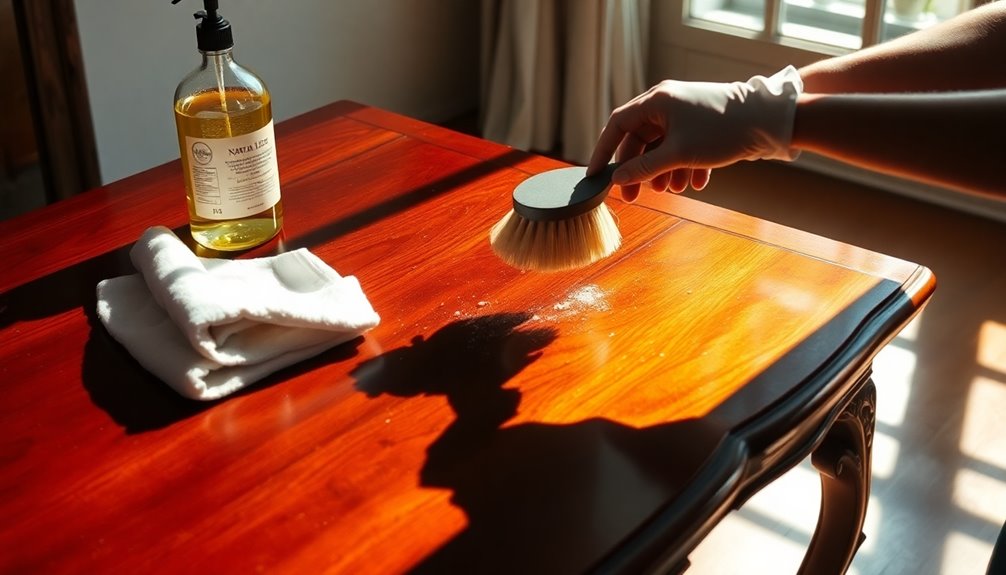Indonesian design welcomes you to a realm where cultural traditions collide with the beauty of nature. Bold and lively color schemes inspired by local textiles infuse spaces with warmth and vitality. Utilizing natural materials such as bamboo and teak wood not only brings in a sense of coziness but also promotes sustainability. Additionally, intricate cultural artifacts share tales of heritage and skilled craftsmanship. This design philosophy centers around harmony, blending contemporary and traditional aspects to cultivate a serene environment. By delving into these principles, you’ll learn how to infuse timeless sophistication into your personal living space and gain a deeper insight into this captivating style.
Key Takeaways
- Indonesian design harmoniously blends cultural heritage with natural beauty, showcasing intricate craftsmanship and reverence for the environment.
- Vibrant color palettes inspired by local textiles create warm, energetic atmospheres while earthy tones foster serenity and connection.
- Natural materials like rattan, bamboo, and reclaimed wood enhance sustainability and promote a calming ambiance through layered textures.
- Cultural artifacts serve as storytelling tools, reflecting Indonesia's rich traditions and enhancing the aesthetic appeal of interiors.
- Emphasis on harmony, balance, and eco-friendly practices defines Indonesian design, promoting well-being and a seamless integration of indoor and outdoor spaces.
Essence of Indonesian Interior Design
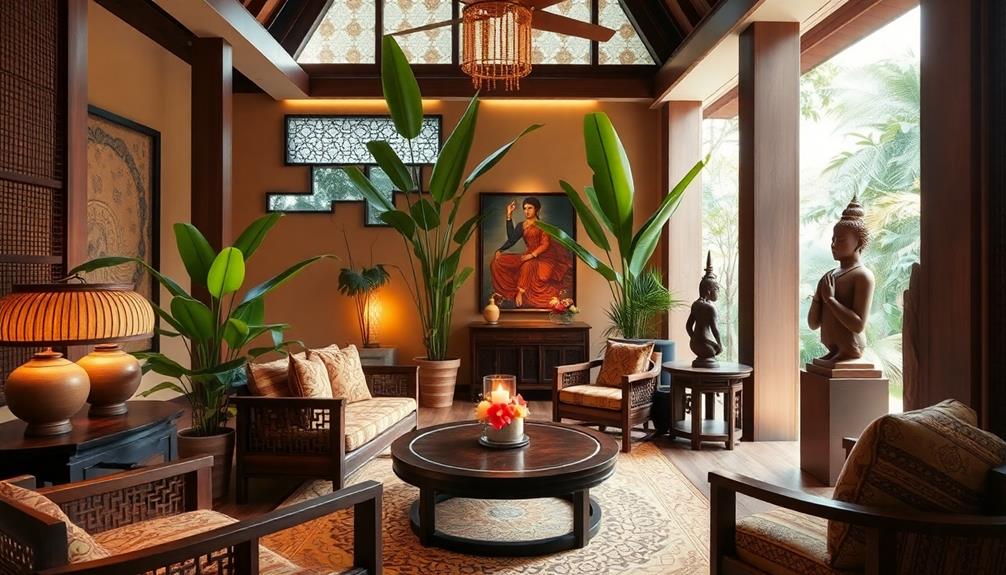
The essence of Indonesian interior design lies in its enchanting blend of cultural heritage and natural beauty. When you step into a space designed with this philosophy, you experience a mesmerizing aesthetic that showcases traditional elements and craftsmanship. Every corner tells a story, often revealed through intricate carvings and patterns that echo Indonesia's rich history.
The use of vibrant colors and intricate patterns in decorative pillows enhances the visual appeal, while handcrafted items reflect the skill of local artisans. These handmade pieces often carry cultural significance, making each item not only a decoration but a story passed down through generations. Many of these designs are created using traditional methods, such as hand tracing techniques, which allow artisans to imprint detailed and personalized motifs onto fabrics. This process ensures each pillow is unique, blending artistic heritage with modern home decor seamlessly.
As you explore these interiors, you'll notice a deep reverence for nature, reflected in the choice of materials like rattan, bamboo, and antique wood. These natural components not only add warmth but also create an organic beauty that resonates with the environment.
The design principles focus on achieving balance between humans, nature, and the divine, encouraging harmony in your living space.
The integration of traditional elements fosters a soulful reflection of Indonesia's vibrant traditions, allowing you to feel connected to the culture. While vibrant colors inspired by local textiles and landscapes infuse energy into the spaces, it's the underlying craftsmanship and storytelling that truly define the essence of Indonesian interior design.
Immerse yourself in this world, and you'll find an inviting atmosphere that celebrates both heritage and nature.
Vibrant Color Palettes

When you explore Indonesian design, you'll notice how local textiles inspire vibrant color palettes.
Rich reds and earthy tones come together to create a warm and energetic atmosphere, reflecting the natural beauty of the landscape. The use of traditional artistry in decor, such as the intricate designs found in Indonesian masks, enhances this colorful aesthetic.
Local Textile Inspirations
Indonesian vibrant color palettes burst forth from local textiles, showcasing the rich hues found in traditional batik prints and ikat patterns. These textiles reflect the country's cultural identity, with each design holding deep cultural significance.
You can also find stunning wall art, like the Indonesian decor mask, that embodies vibrant colors and intricate designs, enhancing your decor's aesthetic. You'll notice the striking reds and deep blues that create energetic atmospheres, reminiscent of Indonesia's lush landscapes. These colors aren't random; they connect to the stories and histories of the communities that create them.
Authenticity shines through in Indonesian textiles, where traditional patterns are meticulously crafted, revealing intricate designs passed down through generations. When you incorporate these textiles into your space, they don't just enhance visual appeal; they add tactile interest, making your interiors feel inviting and connected to Indonesian heritage.
Moreover, the vibrant colors celebrate cultural storytelling, with each textile pattern often representing historical narratives or symbols relevant to local traditions.
Earthy Tone Combinations
Embracing earthy tone combinations can transform your space into a serene sanctuary that reflects Indonesia's stunning landscapes. By incorporating warm browns, muted greens, and soft beiges, you create a calming backdrop that harmoniously complements vibrant accents like rich reds and deep blues.
This dynamic yet grounded aesthetic not only showcases traditional craftsmanship but also celebrates the beauty of nature, as seen in traditional Indonesian style home decor.
Utilizing natural materials such as rattan and reclaimed wood enhances your earthy palette, promoting sustainability and eco-friendliness in your design choices. When you integrate traditional textiles like batik and ikat, you add depth and cultural identity to your interior.
These vibrant patterns effortlessly blend with earthy tones, creating a visually enchanting environment that tells a story. A harmonious mix of earthy tones and vibrant colors doesn't just elevate your space; it fosters a sense of comfort and connection to the natural world.
Remember, the key lies in balance—too much of one can overwhelm the other. By thoughtfully curating your color combinations, you'll achieve a timeless elegance that embodies the essence of Indonesian design.
Let your home reflect the rich cultural heritage and stunning landscapes that inspire it.
Natural Materials and Textures
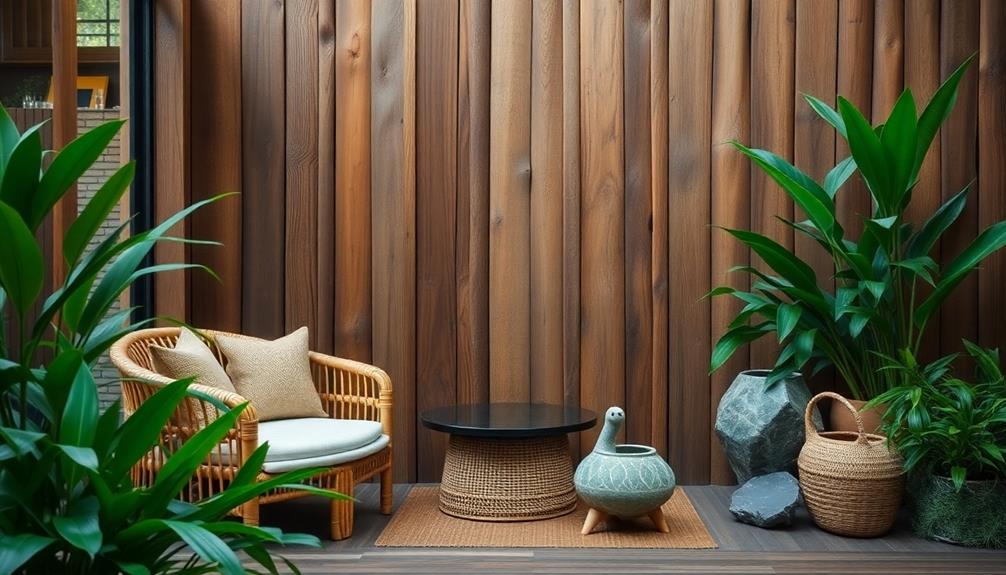
Incorporating natural materials like rattan, bamboo, and reclaimed wood instantly brings warmth and an organic connection to your living space. These materials not only enhance the aesthetic beauty of your interiors but also promote sustainability through responsible sourcing practices. By choosing these elements, you create a tranquil atmosphere that resonates with comfort.
Additionally, the use of earth tones and neutral palettes, as seen in Balinese design concepts, further enhances this calming effect.
Layering textures plays a significant role in Indonesian design. You can enrich your space with rugs, tapestries, and handcrafted furniture, adding depth and visual interest. This attention to detail reflects the rich cultural heritage and traditions of local craftsmanship, making your home not just a place to live but a narrative of history and artistry.
Using natural materials fosters a dialogue between your interiors and the environment, creating harmony that feels both inviting and grounded. The tactile experience these textures provide invites you to engage with your space, turning your home into a sanctuary.
Embrace the beauty of natural materials to cultivate a living environment that celebrates both elegance and eco-friendliness. With thoughtful choices, you'll transform your home into a timeless reflection of Indonesian design principles.
Cultural Artifacts and Their Significance

Cultural artifacts serve as powerful storytelling tools that reflect the rich tapestry of traditions found throughout Indonesia. These objects, from traditional masks to detailed sculptures, embody the cultural identity of various regions and narrate their unique histories.
The intricate craftsmanship involved in creating these artifacts highlights the skills of talented artisans, ensuring that each piece tells a story. For example, the importance of Indonesian decor masks can't be understated, as they not only enhance aesthetic appeal but also serve as conversation starters about Indonesian heritage.
When you incorporate cultural artifacts into your space, you not only enhance its aesthetic appeal but also connect with Indonesia's vibrant traditions. Here are a few examples of these significant artifacts:
- Wayang Kulit: Shadow puppets that depict stories from ancient epics, showcasing storytelling traditions.
- Batik Textiles: Hand-dyed fabrics with intricate patterns that represent different cultural narratives.
- Ceremonial Masks: Used in traditional dances, these masks capture the essence of local beliefs and rituals.
- Wooden Sculptures: Carved with precision, they often symbolize deities or ancestral figures, connecting the past to the present.
Design Principles of Harmony
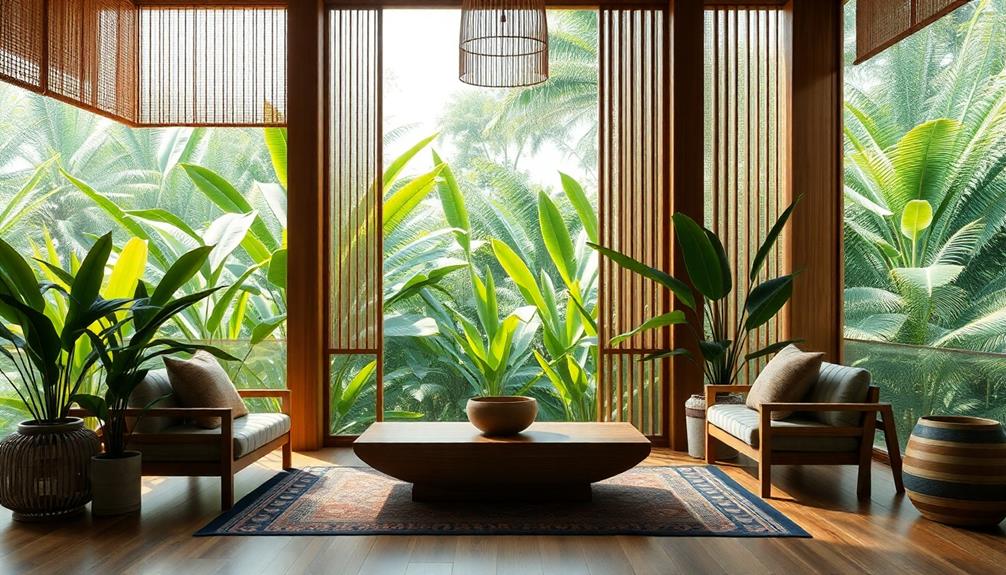
Harmony in design is essential for creating spaces that resonate with tranquility and balance. In Indonesian design principles, achieving equilibrium between humans, nature, and the divine is central. This balance fosters environments that encourage reflection and peace.
You'll notice traditional design elements guide the arrangement of furniture, ensuring each piece enhances the overall harmony of the space. The emphasis on modern tropical aesthetics further underscores the significance of blending indoor and outdoor environments, inviting nature into our living spaces.
Layered textures and natural materials play a vital role in amplifying the design's impact. They create a visual and tactile experience that invites you to engage with your surroundings.
By incorporating vibrant colors and patterns, these principles reflect Indonesia's rich cultural heritage, infusing energy and warmth into your living spaces.
When you embrace these design principles, you're not only creating a beautiful environment but also connecting deeply with Indonesia's traditions and the natural world. The harmony achieved through thoughtful design choices nurtures a soulful atmosphere, making your space a true reflection of tranquility and elegance.
Craftsmanship in Teak Wood Furniture
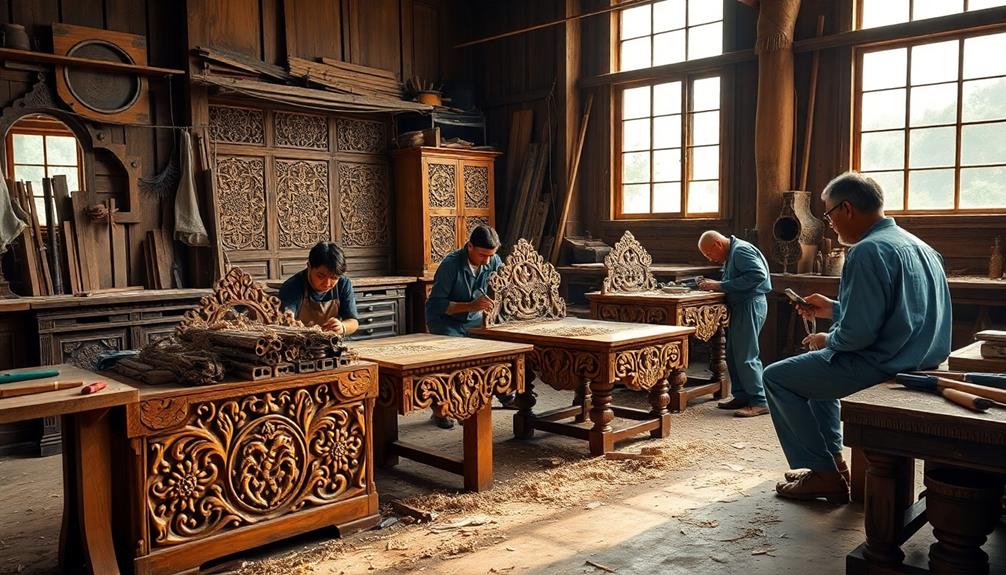
For centuries, Indonesian artisans have honed their skills in crafting exquisite teak wood furniture, reflecting a rich tradition steeped in quality and attention to detail.
The craftsmanship in teak wood furniture showcases a harmonious blend of traditional techniques and modern innovation, guaranteeing each piece isn't only beautiful but also functional. Many of these artisans are recognized for their expert tropical design that incorporates sustainable practices, further enhancing the overall value of their creations.
Here are some key features that make this furniture stand out:
- Durability: Teak wood's natural oils and resistance to decay guarantee your furniture lasts for generations.
- Customization: Each piece can be tailored to your specific preferences, including dimensions, finishes, and features.
- Aesthetic Appeal: The unique grain patterns and warm tones of teak enhance the overall look of any space.
- Artisanal Quality: Skilled artisans pour their expertise into every detail, guaranteeing a high-quality finish that reflects their craftsmanship.
When you invest in Indonesian teak wood furniture, you're not just getting a functional item; you're adding a piece of art that tells a story of dedication and skill.
This commitment to quality and individuality makes Indonesian teak wood furniture a timeless choice for your home.
Sustainable Practices in Indonesian Design
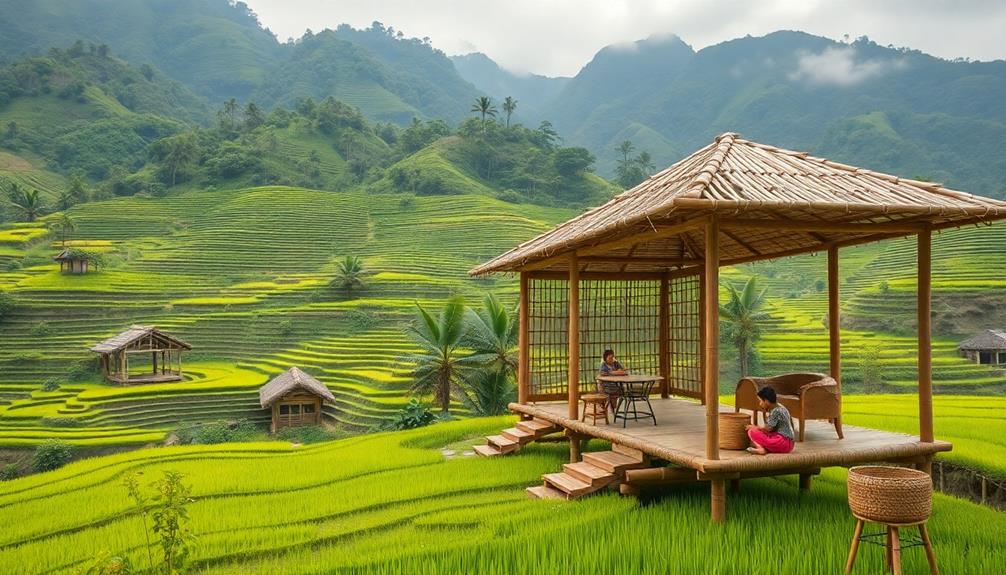
When you explore Indonesian design, you'll notice a strong emphasis on eco-friendly material choices, like bamboo and reclaimed wood.
These materials not only minimize environmental impact but also promote responsible forestry practices.
Traditional Indonesian housing, such as the Rumah Adat, showcases the use of local resources, which highlights the cultural significance of sustainable practices in architecture.
Eco-Friendly Material Choices
A growing number of designers in Indonesia are embracing eco-friendly materials, recognizing their essential role in promoting sustainability. Remarkably, luxury tropical designs are increasingly incorporating these sustainable practices.
By choosing these materials, you're not just enhancing your space; you're also contributing to a healthier planet. The transformative power of eco-friendly materials is evident in the way they create harmony between design and nature.
Here are four popular choices that stand out in Indonesian design:
- Bamboo: Fast-growing and versatile, bamboo is a favorite for its strength and aesthetic appeal.
- Reclaimed Wood: Utilizing reclaimed wood reduces waste and adds a unique character to your interiors.
- Natural Fibers: Fabrics made from jute, cotton, and rattan bring texture and warmth to your space.
- Local Stones: Organic stones provide a natural look and feel, connecting your interiors to the landscape.
As artisans prioritize these eco-conscious options, they not only meet modern consumer demands but also engage communities and support biodiversity conservation.
This holistic approach reflects a deep respect for both the environment and Indonesian cultural heritage, ensuring that your design choices contribute positively to the world around you.
Responsible Forestry Practices
Embracing responsible forestry practices is essential for ensuring the sustainability of Indonesia's rich natural resources. By managing teak forests through sustainable methods, Indonesia actively reduces deforestation and secures the long-term viability of its timber resources.
Certification standards like FSC (Forest Stewardship Council) and FLEGT (Forest Law Enforcement, Governance and Trade) promote legal and sustainable timber sourcing, providing you with the assurance that your choices support ethical practices.
Moreover, Indonesia prioritizes reforestation initiatives to restore degraded areas and preserve biodiversity, playing a critical role in environmental conservation.
You'll find that sustainable options are increasingly popular, especially with eco-friendly materials like bamboo and reclaimed wood making their way into modern designs. These materials not only align with global trends in interior design but also minimize the ecological footprint of your living spaces.
Community engagement is a significant part of this framework, ensuring local populations benefit from responsible forestry through job creation and economic support.
Frequently Asked Questions
What Are Some Popular Indonesian Design Styles?
When exploring popular Indonesian design styles, you'll encounter traditional textiles like Batik, intricate wood carvings, and vibrant colors. You'll also appreciate modern interpretations that blend these elements with contemporary aesthetics, creating a unique cultural fusion.
How Can I Incorporate Indonesian Design in a Small Space?
In a small space, you can juxtapose bold Indonesian textiles with minimalistic furniture. Use vibrant colors in accents, incorporate natural materials, and hang artwork to create a warm, inviting atmosphere that reflects the beauty of Indonesian design.
Are There Specific Maintenance Tips for Indonesian Furniture?
To maintain your Indonesian furniture, regularly dust it with a soft cloth, avoid direct sunlight, and apply oil or wax every few months. This'll keep the wood nourished and preserve its beautiful finish for years.
What Are Common Misconceptions About Indonesian Design?
Some folks think Indonesian design's all about intricate carvings, like assuming a book's only about its cover. In truth, it blends simplicity and functionality, showcasing natural materials that reflect culture and craftsmanship beautifully. This design approach values clean lines and harmonious spaces just as much as ornate details, creating an environment that feels both grounded and peaceful. Just like mastering the best book stacking techniques can balance aesthetics and practicality, Indonesian design weaves together elegance and utility, ensuring every element has a purpose while looking effortlessly beautiful. It’s a style where form truly follows function, with a deep respect for nature’s textures.
Where Can I Find Authentic Indonesian Decor Items?
You can find authentic Indonesian decor items at local artisan markets, specialty home goods stores, or online platforms like Etsy and Amazon. Always look for seller reviews to guarantee you're getting genuine products that reflect Indonesian craftsmanship.
Conclusion
To sum up, Indonesian design beautifully blends tradition with modern elegance, creating spaces that resonate with warmth and character. Did you know that over 70% of Indonesian households incorporate traditional elements in their interiors? This statistic highlights the enduring appeal of cultural authenticity in design. By embracing vibrant colors, natural materials, and skilled craftsmanship, you can transform your space into a stunning reflection of Indonesia's rich heritage. So, let your home tell a story of timeless elegance!
